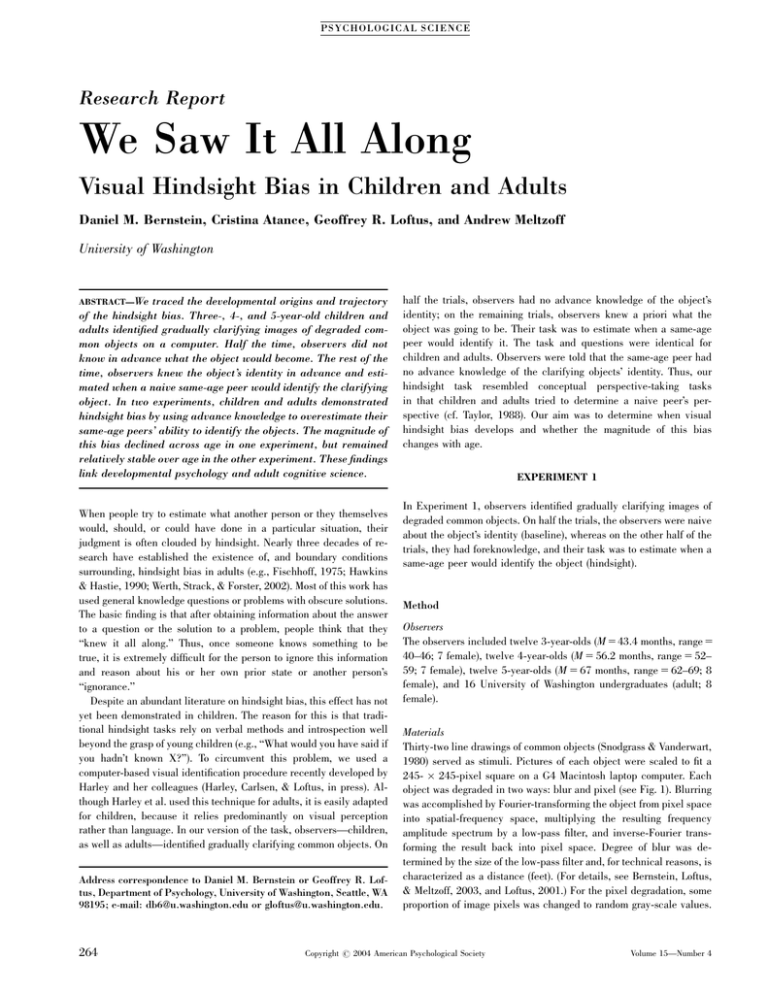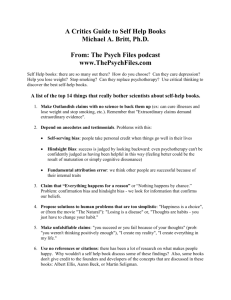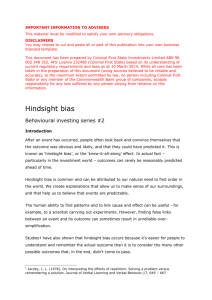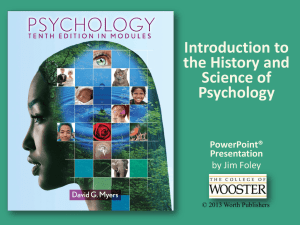We Saw It All Along Research Report
advertisement

PS YC HOLOGIC AL S CIE NCE Research Report We Saw It All Along Visual Hindsight Bias in Children and Adults Daniel M. Bernstein, Cristina Atance, Geoffrey R. Loftus, and Andrew Meltzoff University of Washington ABSTRACT—We traced the developmental origins and trajectory of the hindsight bias. Three-, 4-, and 5-year-old children and adults identified gradually clarifying images of degraded common objects on a computer. Half the time, observers did not know in advance what the object would become. The rest of the time, observers knew the object’s identity in advance and estimated when a naive same-age peer would identify the clarifying object. In two experiments, children and adults demonstrated hindsight bias by using advance knowledge to overestimate their same-age peers’ ability to identify the objects. The magnitude of this bias declined across age in one experiment, but remained relatively stable over age in the other experiment. These findings link developmental psychology and adult cognitive science. When people try to estimate what another person or they themselves would, should, or could have done in a particular situation, their judgment is often clouded by hindsight. Nearly three decades of research have established the existence of, and boundary conditions surrounding, hindsight bias in adults (e.g., Fischhoff, 1975; Hawkins & Hastie, 1990; Werth, Strack, & Forster, 2002). Most of this work has used general knowledge questions or problems with obscure solutions. The basic finding is that after obtaining information about the answer to a question or the solution to a problem, people think that they ‘‘knew it all along.’’ Thus, once someone knows something to be true, it is extremely difficult for the person to ignore this information and reason about his or her own prior state or another person’s ‘‘ignorance.’’ Despite an abundant literature on hindsight bias, this effect has not yet been demonstrated in children. The reason for this is that traditional hindsight tasks rely on verbal methods and introspection well beyond the grasp of young children (e.g., ‘‘What would you have said if you hadn’t known X?’’). To circumvent this problem, we used a computer-based visual identification procedure recently developed by Harley and her colleagues (Harley, Carlsen, & Loftus, in press). Although Harley et al. used this technique for adults, it is easily adapted for children, because it relies predominantly on visual perception rather than language. In our version of the task, observers—children, as well as adults—identified gradually clarifying common objects. On Address correspondence to Daniel M. Bernstein or Geoffrey R. Loftus, Department of Psychology, University of Washington, Seattle, WA 98195; e-mail: db6@u.washington.edu or gloftus@u.washington.edu. 264 half the trials, observers had no advance knowledge of the object’s identity; on the remaining trials, observers knew a priori what the object was going to be. Their task was to estimate when a same-age peer would identify it. The task and questions were identical for children and adults. Observers were told that the same-age peer had no advance knowledge of the clarifying objects’ identity. Thus, our hindsight task resembled conceptual perspective-taking tasks in that children and adults tried to determine a naive peer’s perspective (cf. Taylor, 1988). Our aim was to determine when visual hindsight bias develops and whether the magnitude of this bias changes with age. EXPERIMENT 1 In Experiment 1, observers identified gradually clarifying images of degraded common objects. On half the trials, the observers were naive about the object’s identity (baseline), whereas on the other half of the trials, they had foreknowledge, and their task was to estimate when a same-age peer would identify the object (hindsight). Method Observers The observers included twelve 3-year-olds (M 5 43.4 months, range 5 40–46; 7 female), twelve 4-year-olds (M 5 56.2 months, range 5 52– 59; 7 female), twelve 5-year-olds (M 5 67 months, range 5 62–69; 8 female), and 16 University of Washington undergraduates (adult; 8 female). Materials Thirty-two line drawings of common objects (Snodgrass & Vanderwart, 1980) served as stimuli. Pictures of each object were scaled to fit a 245- 245-pixel square on a G4 Macintosh laptop computer. Each object was degraded in two ways: blur and pixel (see Fig. 1). Blurring was accomplished by Fourier-transforming the object from pixel space into spatial-frequency space, multiplying the resulting frequency amplitude spectrum by a low-pass filter, and inverse-Fourier transforming the result back into pixel space. Degree of blur was determined by the size of the low-pass filter and, for technical reasons, is characterized as a distance (feet). (For details, see Bernstein, Loftus, & Meltzoff, 2003, and Loftus, 2001.) For the pixel degradation, some proportion of image pixels was changed to random gray-scale values. Copyright r 2004 American Psychological Society Volume 15—Number 4 D.M. Bernstein et al. Design There were three independent variables: age (3, 4, 5, adult), degradation type (blur, pixel), and outcome knowledge (baseline, hindsight). Degradation type and outcome knowledge were within-subjects factors whereas age was a between-subjects factor. Procedure Observers were tested, seated in front of a computer, either in their homes or in the laboratory. They received four practice trials, in which they identified images of common objects. The two outcome-knowledge conditions (baseline and hindsight) involved different sets of objects. In the baseline condition, each object was presented from most degraded to least degraded. Observers named the object aloud as soon as they identified it while it clarified. In the hindsight condition, observers first saw the object in full clarity, and were asked, ‘‘What do you think it is?’’ After the child observers responded, they were told, ‘‘Okay, now it’s Ernie’s turn to play.’’ Ernie is a puppet from Sesame Street. He wore felt earphones and was taken out of a bag before being introduced to the children. Adults were simply told about a peer named Ernie. Both children and adults were told that Ernie was the same age as they were, but that he had not seen the object or heard its name. They were told: ‘‘You need to let me know exactly when Ernie sees the [current object]. Say, ‘[current object]’ as soon as Ernie first sees the [current object].’’ The object then clarified just as it had in the baseline condition. The experimenter (D.M.B.) stopped the object clarification when children indicated that Ernie saw the object (e.g., ‘‘now he sees it’’ or ‘‘[current object]’’). The experimenter typed the children’s responses for them. Adult observers pressed a key to stop the presentation of images when they felt they could identify the object and typed their own responses. Fig. 1. Examples of the stimulus degradations. Experiment 1 included blur and pixel degradations. Experiment 2 included blur and crop degradations. Degree of pixel degradation was characterized as the noise-to-signal ratio: p/(1 p), where p is the proportion of changed pixels. For each object and each degradation type, we designed 15 increasingly degraded images such that differences between successive degraded images were roughly equal perceptually. During the course of a trial, the object presented clarified from fully degraded to clear. Each of the 15 images remained on screen for 1,000 ms, and then was replaced by the next, less degraded image.1 Counterbalancing On each trial, observers viewed clarifying images of an object. The experimental session consisted of four blocks with eight trials per block. For a given block of trials, degradation type (i.e., blur or pixel) and outcome knowledge (i.e., baseline or hindsight) remained constant. The four experimental conditions were counterbalanced within each age group. A different object order was randomly generated for each set of 4 observers within each age group. The same object orders were used for each of the four age groups. 1 As part of another project, children completed three false belief tasks, but these data are not relevant to present concerns and are not presented here. Volume 15—Number 4 Results and Discussion Child and adult observers identified more than 96% of the objects. Only responses for correctly identified objects were analyzed. Our main question was whether all four age groups demonstrated hindsight bias. We calculated hindsight bias for each degradation type as the ratio of the identification point in the hindsight condition divided by the identification point in the baseline condition (see Materials in Bernstein et al., 2003, for discussion of how the identification point was defined for each degradation). These ratios appear in Figure 2.2 Note that a ratio value greater than 1.0 indicates hindsight bias, that is, the observer identified the object at a more degraded level in the hindsight condition than in the baseline condition. All groups showed hindsight: For no group did the 95% confidence interval include 1.0. Across the four groups, the average hindsight effects were 1.91 0.22 and 1.69 0.19 for the blur and pixel conditions, respectively.3 Figure 2 shows that hindsight bias declined with age. We demonstrated this in two ways. First, we applied a contrast for monotonic decline to the log ratios of the four age groups (weights 5 6, 1, 1, 6) for each degradation type. The magnitudes of this contrast were 1.89 1.17 and 1.49 1.30 for blur and pixel degradations, respectively; that is, neither confidence interval 2 The data from one 4-year-old were not analyzed, because her blur and pixel hindsight values (5.5 and 14.9, respectively) were well above the values for the rest of her group. 3 In this article, y x refers to the 95% confidence interval around the mean. 265 We Saw It All Along Fig. 2. Experiment 1 results. Error bars are 95% confidence intervals. Naive 5 baseline condition. included zero. Second, we calculated the ratio of children’s to adults’ hindsight scores. These ratios were 1.69 (95% confidence interval 5 1.30–2.20) and 1.62 (95% confidence interval 5 1.23–2.13) for the blur and pixel degradations, respectively; again, neither confidence interval included 1.0. In summary, (a) preschool children and adults exhibited hindsight bias by claiming that a naive same-age peer could identify images at a more degraded level than they themselves were able to, and (b) the magnitude of this bias declined from childhood to adulthood for both degradation types. EXPERIMENT 2 The results of Experiment 1 indicate that children and adults are both susceptible to visual hindsight bias and that this bias declines with age. It is possible, however, that the observed hindsight bias resulted from using different objects in the baseline and hindsight conditions. Research in adults has shown that hindsight bias occurs whether individuals answer different questions (in our case, questions about different objects) in the baseline and hindsight conditions or the same set of questions twice. To test whether these findings would generalize to child observers, in Experiment 2 we presented the same objects for identification in the baseline and hindsight conditions. We also replaced the pixel degradation with a cropping degradation. Method Observers The observers were twenty 3-year-olds (M543.3 months, range538– 47; 13 female), twelve 4-year-olds (M 5 54 months, range 5 49–59; 6 female), twelve 5-year-olds (M 5 66.75 months, range 5 62–79; 7 female), and 12 University of Washington undergraduates (adult; 8 female). Materials and Counterbalancing The materials and clarification process were similar to those of Experiment 1, with the following exceptions. There were 16 objects, each 266 shown twice (once in the baseline condition and once in the hindsight condition). Instead of 15 images of each object, we designed 30 images. In the crop condition, we cropped the object and then presented expanding portions of it, beginning in the middle and expanding to the borders (see Fig. 1). As with the blur condition, we measured degree of crop in terms of distance in feet (see Bernstein et al., 2003, for details). Unlike in Experiment 1, the clarification procedure was not continuous. Objects clarified as follows: Each image remained on screen for 600 ms and was then replaced by the next, clearer one. After the 8th image was displayed, it remained on screen until the observer responded. Then, over the 22 remaining images, the image halted after every 3rd image had been displayed. Thus, there were eight stopping points over the 30 images of each object. This new clarification procedure permitted us to collect observers’ responses at eight discrete points in time. In contrast, in Experiment 1, observers halted the image clarification to identify the object. Stimulus counterbalancing was done as in Experiment 1, except that a different object order was randomly generated for each set of 2 (instead of 4) observers within each age group. The same object order was used in the baseline and hindsight conditions. Design The design was identical to the design of Experiment 1. Procedure The procedure was similar to that of Experiment 1, except that each object was shown in both the baseline and hindsight conditions. Therefore, observers first identified objects in the two baseline conditions (blur and crop), and then estimated when Ernie identified the same objects as they clarified in the hindsight conditions. Observers were not told about Ernie until they had completed the two baseline conditions. For adults, the name of each object appeared on screen prior to each trial in the hindsight conditions. Children were told the object’s name (e.g., ‘‘This is going to be the fish’’). After each stopping point in the baseline (and hindsight) conditions, observers were asked, ‘‘What do you (does Ernie) see right now?’’ Children often responded to this question with answers like ‘‘nothing,’’ ‘‘not yet,’’ or ‘‘show me more’’ before identifying the object. Results and Discussion Child and adult observers identified more than 99% of the objects.4 Only the data for correctly identified objects were analyzed. We calculated hindsight bias as in Experiment 1, and the ratios are shown in Figure 3. The overall hindsight effect was less evident than it was in Experiment 1; however, across the four groups hindsight emerged: The average hindsight effects were 1.70 0.25 and 1.32 0.17 for the blur and crop conditions, respectively. To determine whether the hindsight bias declined with age, we carried out analyses analogous to those in Experiment 1. The magnitudes of the monotonic-decrease contrast were 0.57 0.90 and 0.42 0.93 for the blur and pixel conditions, respectively; that is, both confidence intervals included zero. The ratios of children’s to adults’ hindsight effects were 1.25 (95% confidence interval 5 1.10–1.42) and 1.10 (95% confidence 4 The data from one 4-year-old and one 5-year-old were not analyzed, because their blur and crop hindsight values (0.72 and 0.45 for the 4-year-old and 0.21 and 0.34 for the 5-year-old) were well below the values for the rest of their respective groups. Volume 15—Number 4 D.M. Bernstein et al. mind tasks around age 4 is not mirrored by a sharp decrease in visual hindsight bias as measured by our test (but see Birch & Bloom, 2003, for a demonstration of decreased errors in a related task; also see Royzman, Cassidy, & Baron, 2003). The current findings also may have applied significance for both adult and child eyewitness testimony, because in retrospect, observers tend to believe that viewing conditions at the scene of a crime were better than they actually were. The present approach provides valuable interdisciplinary tools for studying perception and cognition from a combined developmental and cognitive science standpoint. Acknowledgments—This work was supported by the University of Washington’s Center for Mind, Brain & Learning; the Talaris Research Institute; the Apex Foundation (the family foundation of Bruce and Jolene McCaw); and National Institute of Mental Health Grant MH41637 to G. Loftus. We thank Erin Harley for her insights. Fig. 3. Experiment 2 results. Error bars are 95% confidence intervals. Naive 5 baseline condition. REFERENCES interval 5 0.84–1.41) for the blur and crop conditions, respectively; that is, only the blur condition excluded the null ratio of 1.0. In summary, the results of Experiment 2 replicate the main finding of Experiment 1: Children ages 3 to 5 and adults showed visual hindsight bias in a computer object identification task. Unlike Experiment 1, however, Experiment 2 did not yield clear evidence that hindsight bias declined with age. GENERAL DISCUSSION In two experiments, preschoolers (3-, 4-, and 5-year-olds) and adults exhibited visual hindsight bias on the same object identification task. Our task was structured such that half the time, observers did not know the object’s identity a priori as it clarified (baseline), whereas the other half of the time, they knew the object’s identity before estimating when a naive, same-age peer would identify the object (hindsight). When observers knew the object’s identity, they overestimated their peer’s knowledge by claiming that he would identify the object before they themselves could. This visual hindsight bias occurred for two different types of visual degradation in each experiment and was obtained whether observers were tested on different objects (Experiment 1) or the same objects (Experiment 2) in the baseline and hindsight conditions. In sum, there was strong evidence that hindsight bias develops early in life and persists into adulthood (see Jacobs & Klaczynski, 2002). Hindsight bias clearly declined with age in Experiment 1, but not in Experiment 2. The current findings may have implications for the development of theory of mind. Both hindsight and theory-of-mind tasks, such as representational change (Gopnik & Astington, 1988), require children to reason about their own, or another person’s, state of ignorance. However, the substantial improvement in performance in theory-of- Volume 15—Number 4 Bernstein, D.M., Loftus, G.R., & Meltzoff, A. (2003). Object identification in preschool children and adults. Manuscript submitted for publication. Birch, S., & Bloom, P. (2003). Children are cursed: An asymmetric bias in mental-state attribution. Psychological Science, 14, 283–286. Fischhoff, B. (1975). Hindsight 6¼ foresight: The effect of outcome knowledge on judgment under uncertainty. Journal of Experimental Psychology: Human Perception and Performance, 1, 288–299. Gopnik, A., & Astington, J.W. (1988). Children’s understanding of representational change and its relation to the understanding of false belief and the appearance-reality distinction. Child Development, 59, 26–37. Harley, E.M., Carlsen, K.A., & Loftus, G.R. (in press). The ‘‘I saw it all along’’ effect: Demonstrations of visual hindsight bias. Journal of Experimental Psychology: Learning, Memory, and Cognition. Hawkins, S.A., & Hastie, R. (1990). Hindsight: Biased judgment of past events after the outcomes are known. Psychological Bulletin, 107, 311–327. Jacobs, J.E., & Klaczynski, P.A. (2002). The development of judgment and decision making during childhood and adolescence. Current Directions in Psychological Science, 11, 145–149. Loftus, G.R. (2001, November). Recognizing faces at a distance. Paper presented at the annual meeting of the Psychonomic Society, Orlando, FL. Royzman, E.B., Cassidy, K.W., & Baron, J. (2003). ‘‘I know, you know’’: Epistemic egocentrism in children and adults. Review of General Psychology, 7, 38–65. Snodgrass, J.G., & Vanderwart, M. (1980). A standardized set of 260 pictures: Norms for name agreement, image agreement, familiarity, and visual complexity. Journal of Experimental Psychology: Human Learning and Memory, 6, 174–215. Taylor, M. (1988). Conceptual perspective taking: Children’s ability to distinguish what they know from what they see. Child Development, 59, 703– 718. Werth, L., Strack, F., & Forster, J. (2002). Certainty and uncertainty: The two faces of the hindsight bias. Organizational Behavior and Human Decision Processes, 87, 323–341. (RECEIVED 1/22/03; ACCEPTED 3/3/03) 267





